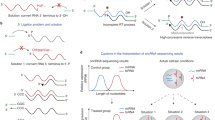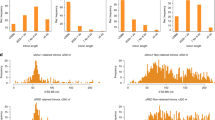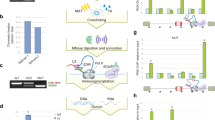Abstract
Efforts to catalog eukaryotic transcripts have uncovered many small RNAs (sRNAs) derived from gene termini and splice sites. Their biogenesis pathways are largely unknown, but a mechanism based on backtracking of RNA polymerase II (RNAPII) has been suggested. By sequencing transcripts 12–100 nucleotides in length from cells depleted of major RNA degradation enzymes and RNAs associated with Argonaute (AGO1/2) effector proteins, we provide mechanistic models for sRNA production. We suggest that neither splice site–associated (SSa) nor transcription start site–associated (TSSa) RNAs arise from RNAPII backtracking. Instead, SSa RNAs are largely degradation products of splicing intermediates, whereas TSSa RNAs probably derive from nascent RNAs protected by stalled RNAPII against nucleolysis. We also reveal new AGO1/2-associated RNAs derived from 3′ ends of introns and from mRNA 3′ UTRs that appear to draw from noncanonical microRNA biogenesis pathways.
This is a preview of subscription content, access via your institution
Access options
Subscribe to this journal
Receive 12 print issues and online access
$189.00 per year
only $15.75 per issue
Buy this article
- Purchase on Springer Link
- Instant access to full article PDF
Prices may be subject to local taxes which are calculated during checkout






Similar content being viewed by others
Accession codes
Change history
21 August 2011
In the version of this article initially published online, in Figure 5a, the x-axis tick marks and labels were placed incorrectly; in Figure 5c, there were two extraneous tracks; and in Figure 5d, the y-axis label was missing, a stem in the RNA was incorrectly colored in gray (instead of red) and the sRNA tracks were incorrectly shifted to the left. These errors have been corrected for the print, PDF and HTML versions of this article.
References
Jacquier, A. The complex eukaryotic transcriptome: unexpected pervasive transcription and novel small RNAs. Nat. Rev. Genet. 10, 833–844 (2009).
Forrest, A.R. & Carninci, P. Whole genome transcriptome analysis. RNA Biol. 6, 107–112 (2009).
Taft, R.J., Kaplan, C.D., Simons, C. & Mattick, J.S. Evolution, biogenesis and function of promoter-associated RNAs. Cell Cycle 8, 2332–2338 (2009).
Seila, A.C., Core, L.J., Lis, J.T. & Sharp, P.A. Divergent transcription: a new feature of active promoters. Cell Cycle 8, 2557–2564 (2009).
Preker, P., Nielsen, J., Schierup, M.H. & Jensen, T.H. RNA polymerase plays both sides: vivid and bidirectional transcription around and upstream of active promoters. Cell Cycle 8, 1106–1107 (2009).
Berretta, J. & Morillon, A. Pervasive transcription constitutes a new level of eukaryotic genome regulation. EMBO Rep. 10, 973–982 (2009).
Krol, J., Loedige, I. & Filipowicz, W. The widespread regulation of microRNA biogenesis, function and decay. Nat. Rev. Genet. 11, 597–610 (2010).
Carthew, R.W. & Sontheimer, E.J. Origins and mechanisms of miRNAs and siRNAs. Cell 136, 642–655 (2009).
Bartel, D.P. MicroRNAs: target recognition and regulatory functions. Cell 136, 215–233 (2009).
Hutvagner, G. & Simard, M.J. Argonaute proteins: key players in RNA silencing. Nat. Rev. Mol. Cell Biol. 9, 22–32 (2008).
Peters, L. & Meister, G. Argonaute proteins: mediators of RNA silencing. Mol. Cell 26, 611–623 (2007).
Kapranov, P. et al. RNA maps reveal new RNA classes and a possible function for pervasive transcription. Science 316, 1484–1488 (2007).
Affymetrix/Cold Spring Harbor Laboratory ENCODE Transcriptome Project. Post-transcriptional processing generates a diversity of 5′-modified long and short RNAs. Nature 457, 1028–1032 (2009).
Seila, A.C. et al. Divergent transcription from active promoters. Science 322, 1849–1851 (2008).
Taft, R.J. et al. Tiny RNAs associated with transcription start sites in animals. Nat. Genet. 41, 572–578 (2009).
Taft, R.J. et al. Nuclear-localized tiny RNAs are associated with transcription initiation and splice sites in metazoans. Nat. Struct. Mol. Biol. 17, 1030–1034 (2010).
Kapranov, P. et al. New class of gene-termini-associated human RNAs suggests a novel RNA copying mechanism. Nature 466, 642–646 (2010).
Preker, P. et al. PROMoter uPstream Transcripts share characteristics with mRNAs and are produced upstream of all three major types of mammalian promoters. Nucleic Acids Res. published online, doi:10.1093/nar/gkr370 (19 May 2011).
Linsen, S.E. et al. Limitations and possibilities of small RNA digital gene expression profiling. Nat. Methods 6, 474–476 (2009).
Gu, W. & Reines, D. Variation in the size of nascent RNA cleavage products as a function of transcript length and elongation competence. J. Biol. Chem. 270, 30441–30447 (1995).
Izban, M.G. & Luse, D.S. The increment of SII-facilitated transcript cleavage varies dramatically between elongation competent and incompetent RNA polymerase II ternary complexes. J. Biol. Chem. 268, 12874–12885 (1993).
Nechaev, S. et al. Global analysis of short RNAs reveals widespread promoter-proximal stalling and arrest of Pol II in Drosophila. Science 327, 335–338 (2010).
Sandelin, A. et al. Mammalian RNA polymerase II core promoters: insights from genome-wide studies. Nat. Rev. Genet. 8, 424–436 (2007).
Carninci, P. et al. Genome-wide analysis of mammalian promoter architecture and evolution. Nat. Genet. 38, 626–635 (2006).
Guenther, M.G., Levine, S.S., Boyer, L.A., Jaenisch, R. & Young, R.A. A chromatin landmark and transcription initiation at most promoters in human cells. Cell 130, 77–88 (2007).
Zeitlinger, J. et al. RNA polymerase stalling at developmental control genes in the Drosophila melanogaster embryo. Nat. Genet. 39, 1512–1516 (2007).
Muse, G.W. et al. RNA polymerase is poised for activation across the genome. Nat. Genet. 39, 1507–1511 (2007).
Rahl, P.B. et al. c-Myc regulates transcriptional pause release. Cell 141, 432–445 (2010).
Mavrich, T.N. et al. Nucleosome organization in the Drosophila genome. Nature 453, 358–362 (2008).
Rozowsky, J. et al. PeakSeq enables systematic scoring of ChIP-seq experiments relative to controls. Nat. Biotechnol. 27, 66–75 (2009).
Brueckner, F. et al. Structure-function studies of the RNA polymerase II elongation complex. Acta Crystallogr. D Biol. Crystallogr. 65, 112–120 (2009).
Okamura, K., Hagen, J.W., Duan, H., Tyler, D.M. & Lai, E.C. The mirtron pathway generates microRNA-class regulatory RNAs in Drosophila. Cell 130, 89–100 (2007).
Ruby, J.G., Jan, C.H. & Bartel, D.P. Intronic microRNA precursors that bypass Drosha processing. Nature 448, 83–86 (2007).
Flynt, A.S., Greimann, J.C., Chung, W.J., Lima, C.D. & Lai, E.C. MicroRNA biogenesis via splicing and exosome-mediated trimming in Drosophila. Mol. Cell 38, 900–907 (2010).
Babiarz, J.E., Ruby, J.G., Wang, Y., Bartel, D.P. & Blelloch, R. Mouse ES cells express endogenous shRNAs, siRNAs, and other Microprocessor-independent, Dicer-dependent small RNAs. Genes Dev. 22, 2773–2785 (2008).
Maroney, P.A., Chamnongpol, S., Souret, F. & Nilsen, T.W. Direct detection of small RNAs using splinted ligation. Nat. Protoc. 3, 279–287 (2008).
Burroughs, A.M. et al. A comprehensive survey of 3′ animal miRNA modification events and a possible role for 3′ adenylation in modulating miRNA targeting effectiveness. Genome Res. 20, 1398–1410 (2010).
Lee, C. et al. NELF and GAGA factor are linked to promoter-proximal pausing at many genes in Drosophila. Mol. Cell. Biol. 28, 3290–3300 (2008).
Jimeno-González, S., Haaning, L.L., Malagon, F. & Jensen, T.H. The yeast 5′–3′ exonuclease Rat1p functions during transcription elongation by RNA polymerase II. Mol. Cell 37, 580–587 (2010).
Berezikov, E., Chung, W.J., Willis, J., Cuppen, E. & Lai, E.C. Mammalian mirtron genes. Mol. Cell 28, 328–336 (2007).
Glazov, E.A. et al. A microRNA catalog of the developing chicken embryo identified by a deep sequencing approach. Genome Res. 18, 957–964 (2008).
Glazov, E.A. et al. Repertoire of bovine miRNA and miRNA-like small regulatory RNAs expressed upon viral infection. PLoS ONE 4, e6349 (2009).
Chiang, H.R. et al. Mammalian microRNAs: experimental evaluation of novel and previously annotated genes. Genes Dev. 24, 992–1009 (2010).
Chung, W.J. et al. Computational and experimental identification of mirtrons in Drosophila melanogaster and Caenorhabditis elegans. Genome Res. 21, 286–300 (2011).
Kozomara, A. & Griffiths-Jones, S. miRBase: integrating microRNA annotation and deep-sequencing data. Nucleic Acids Res. 39, D152–D157 (2011).
Berezikov, E. et al. Evolutionary flux of canonical microRNAs and mirtrons in Drosophila. Nat. Genet. 42, 6–9, author reply 9–10 (2010).
Yang, Y. et al. RNA secondary structure in mutually exclusive splicing. Nat. Struct. Mol. Biol. 18, 159–168 (2011).
Gao, K., Masuda, A., Matsuura, T. & Ohno, K. Human branch point consensus sequence is yUnAy. Nucleic Acids Res. 36, 2257–2267 (2008).
Halic, M. & Moazed, D. Dicer-independent primal RNAs trigger RNAi and heterochromatin formation. Cell 140, 504–516 (2010).
Li, C. et al. Collapse of germline piRNAs in the absence of Argonaute3 reveals somatic piRNAs in flies. Cell 137, 509–521 (2009).
Malone, C.D. et al. Specialized piRNA pathways act in germline and somatic tissues of the Drosophila ovary. Cell 137, 522–535 (2009).
Saito, K. et al. A regulatory circuit for piwi by the large Maf gene traffic jam in Drosophila. Nature 461, 1296–1299 (2009).
Olivieri, D., Sykora, M.M., Sachidanandam, R., Mechtler, K. & Brennecke, J. An in vivo RNAi assay identifies major genetic and cellular requirements for primary piRNA biogenesis in Drosophila. EMBO J. 29, 3301–3317 (2010).
Robine, N. et al. A broadly conserved pathway generates 3′UTR-directed primary piRNAs. Curr. Biol. 19, 2066–2076 (2009).
Preker, P. et al. RNA exosome depletion reveals transcription upstream of active human promoters. Science 322, 1851–1854 (2008).
Ender, C. et al. A human snoRNA with microRNA-like functions. Mol. Cell 32, 519–528 (2008).
Rüdel, S., Flatley, A., Weinmann, L., Kremmer, E. & Meister, G. A multifunctional human Argonaute2-specific monoclonal antibody. RNA 14, 1244–1253 (2008).
Langmead, B., Trapnell, C., Pop, M. & Salzberg, S.L. Ultrafast and memory-efficient alignment of short DNA sequences to the human genome. Genome Biol. 10, R25 (2009).
Zhao, X., Valen, E., Parker, B. & Sandelin, A. Systematic clustering of transcription start site landscapes. PLoS ONE (in the press).
Zhang, Y. et al. Model-based analysis of ChIP-Seq (MACS). Genome Biol. 9, R137 (2008).
Acknowledgements
We thank A. Jacquier, A.H. Lund, K. Adelman and members of the T.H.J. and A.S. laboratories for stimulating discussions. The following colleagues are acknowledged for sharing antibodies: J. Lykke-Andersen (Division of Biology, University of California, San Diego), D.L. Black (Howard Hughes Medical Institute, Department of Microbiology, Immunology and Molecular Genetics, University of California, Los Angeles), G.J. Pruijn (Department of Biomolecular Chemistry, Nijmegen Center for Molecular Life Sciences, Institute for Molecules and Materials, Radboud University) and K. Nishikura (The Wistar Institute). This work was supported by the Danish National Research Foundation, the Danish Cancer Society and the Lundbeck Foundation (to T.H.J.) and the EU 7th Framework Programme (FP7/2007–2013)/ERC grant agreement 204135, the Novo Nordisk Foundation, the Danish Cancer Society and the Lundbeck Foundation (to A.S.). E.V. was supported by the Danish Council for Independent Research. P.P. was the recipient of a research grant from the Lundbeck Foundation during part of this work. Work in the laboratory of G.M. was supported by the Bayerisches Staatsministerium für Wissenschaft, Forschung und Kunst (BayGene), the European Union (ERC grant 'sRNAs') and the Deutsche Forschungsgemeinschaft (DFG, Me 2064/2-2 and FOR855). Sequencing was carried out at the Beijing Genome Institute (BGI) in Shenzhen, China.
Author information
Authors and Affiliations
Contributions
E.V., P.P., P.R.A., G.M., A.S. and T.H.J. designed the experiments. P.P., P.R.A., C.E. and A.D. conducted the experiments. E.V., X.Z., Y.C. and A.S. did the bioinformatics analyses. E.V., P.P., P.R.A., G.M., A.S. and T.H.J. evaluated the results. E.V., P.P., P.R.A., X.Z., Y.C., A.S. and T.H.J. produced the figures. E.V., P.P., P.R.A., A.S. and T.H.J. wrote the manuscript.
Corresponding authors
Ethics declarations
Competing interests
The authors declare no competing financial interests.
Supplementary information
Supplementary Text and Figures
Supplementary Figures 1–9 and Supplementary Tables 1 and 2 (PDF 10261 kb)
Rights and permissions
About this article
Cite this article
Valen, E., Preker, P., Andersen, P. et al. Biogenic mechanisms and utilization of small RNAs derived from human protein-coding genes. Nat Struct Mol Biol 18, 1075–1082 (2011). https://doi.org/10.1038/nsmb.2091
Received:
Accepted:
Published:
Issue Date:
DOI: https://doi.org/10.1038/nsmb.2091
This article is cited by
-
Regulation of microRNA biogenesis and its crosstalk with other cellular pathways
Nature Reviews Molecular Cell Biology (2019)
-
Deep intronic mutations and human disease
Human Genetics (2017)
-
Novel equine tissue miRNAs and breed-related miRNA expressed in serum
BMC Genomics (2016)
-
Senataxin suppresses the antiviral transcriptional response and controls viral biogenesis
Nature Immunology (2015)
-
Meta-analysis of tRNA derived RNA fragments reveals that they are evolutionarily conserved and associate with AGO proteins to recognize specific RNA targets
BMC Biology (2014)



